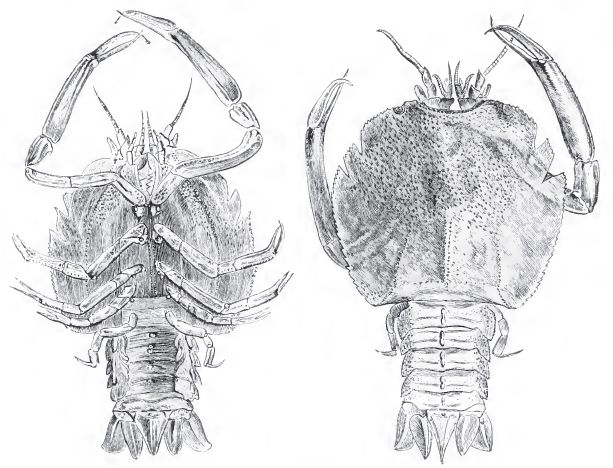
Eryon (Cycleryon) propinquus, Solnhofen; from Zittel & Eastman 1913
| Decapoda | ||
| Arthropoda | Eryonoidea |
| Arthropoda | Eucarida
└─► |
|||
| Malacostraca | None |
Hexapoda |
|
Abbreviated Dendrogram
Malacostraca
│
└─Decapoda
├─Dendrobranchiata
└─┬─Caridea
└─Reptantia
├─Eryonoidea
│ ├─Tetrachela
│ └─┬─Eryonidae
│ └─┬─Palaeopentacheles
│ └─┬─Coleiidae
│ └─Polychelidae
└─Eureptantia
├─Astacidea
├─Palinuroidea
└─┬─Anomura
└─Brachyura
|
Contents
Overview |
Taxa on This Page
 Eryon (Cycleryon) propinquus, Solnhofen; from Zittel & Eastman 1913 |
When the present writer (MAK) was a kid, filling his suggestable mind with images from aleontology textbooks, among those creatures that stood out was a bizarre crustacean described as a lobster, but looking nothing like one. Instead it had a flat, discoidal body and elongate and delicate, tong-like pincers. Yet this strange creature, called Eryon (see image above) lived not during the Paleozoic, when the oceans were populated by such iconic prehistoric arthropods as trilobites, eurypterids, phyllocarids, and horseshoe crabs, but in the late Jurassic, at a time when invertebrates (apart from the abundant ammonites and belemnites), looked pretty much like those around today. Even the name is prehistoric sounding, recalling Eryops, the famous Permian amphibian who is often portyayed alongside the finback Dimetrodon (although the two probably occupied very different environments).
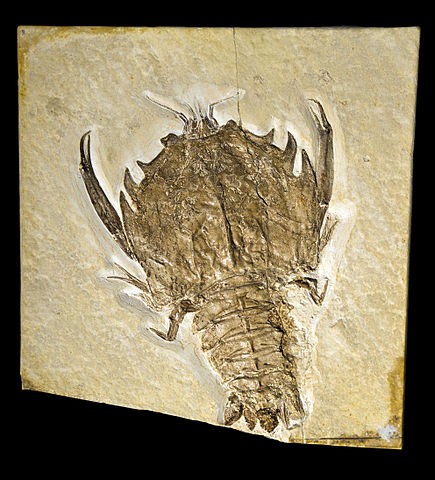 Eryon arctiformis, Solnhofen Photo by Didier Descouens, via Wikipedia, Creative Commons Attribution Share Alike/GNU Free Documentation License. |
As it turns out, Eryon is not ancient Greek for "weird crab -like creature with long thin claws" but means "red" (Wikipedia) , no doubt recalling the colour of the fossils in the Solnhofen lithographic limitestone where it is found. And the commonly portrayed Eryon propinquus is now called Cycleryon propinquus (Round Eryon), although whether it deserves a distinct genus name (and whether it is any rounder) is debatable considering the similarity between the respective type species. In any case, these animals clearly constituted a paraphyletic assemblage or evolutionary gradation
.And rather than call Eryon a lobster (or a crab), it is better referred to as a member of the walking clade of decapods, Reptantia. Cladistic analysis (Scholtz & Richter in 1995 and Dixon et al in 2003) shows that it belongs to the most basal (primitive, ancestral) lineage of reptants. Once common, they are today a relict group. Extant forms constitute a small number of genera, such as Polycheles and Willemoesia which have chelae on the first four or on all five pairs of legs. All are blind or with greatly reduced eyes, and inhabit deep water. Fossil genera however include forms that lived in shallow water, and all possessed well-developed eyes. The earliest is Tetrachela from the Late Triassic. Eryonoids reach their greatest diervisty during the Jurassic, with a number of species known from the Solnhofen lagerstatte alone (Late Kimmeridgian/Early Tithonian) (Zittel & Eastman 1913, Ahyong 2009). By the late Cretaceous and early Tertiary they were in decline, Today only a single family (Polychelidae) remains, perhaps due to absense of rivals in its deepwater environment. These have a narrower and hence more conventionally lobster-like body shape. All eryonoids are distinguished by claws not only on the elongate first pair of limbs (the pincers), but on at least three pairs of walkng legs, hence their alternative (and currently widely used) name, Polychelida (many claws). This distinguishes them from the distantly related Palinuroidea, who have no claws at all, not even pincers, Why some lobster-like animals should have delicate and lightly built claws, others (the classic lobsters and crabs) powerfully built cutting and crushing claws, and others no claws at all, shows how functionally and ecomorpghcllay diverse life can be, even among closely related types. MAK120531
The Eryonoidea form a distinct and fairly orthogenetic evolutionary series, evolving along a single direction. From the abstract by Ahyong 2009 - "Phylogenetic trends include a general narrowing of the carapace and abdomen; shortening of the carapace front with respect to the anterolateral margins, leading to a shift in eye orientation from anterior to transverse; dorsal exposure of the base of the antennules and development of a stylocerite; and a shift in the form of the major chelipeds from relatively robust with short, triangular carpi to elongated and slender, with slender carpi. These trends within Polychelida appear to correspond to a shift from a shallow-water, epibenthic habit to the deep-water, fossorial lifestyle" These trends can be seen in the illustrations accompanying ecah taxon, below. The earliest and most primitive forms are squat and broad, the later types have a more conventional appearance. However, this was not simply like the old pictures of the evolution of the horse, because the various types evolved in parallel alongside each other. MAK120531
The superfamily Eryonoidea, containing the two families Polychelidae and Eryonidea, has until recently been included as one of the three superfamilies of the infraorder Palinura, alongside the mostly fossil Glypheoidea, and the Palinuroidea, which include the spiny lobsters and slipper lobsters (e.g. Barnes 1980, Holthuis 1991). In 1995, Gerhard Scholtz and Stefan Richter of the Freie Universität Berlin the first proper cladistic study of the decapoda and specifically the Reptantia (Scholtz & Richter 1995). They found that the "Palinura" as defined up until then was paraphyletic. They therefore abandoned that taxon and replaced the Eryonoidea with the new non-rank clade Polychelida, and the Palinuroidea with the non-rank Achelata.
Due to the influence of Scholtz & Richter's important paper, the earlier terms Eryonoidea and Palinuroidea are noew very rarely used. Since however Polychelida is identical in every respect to the earlier-named taxon Eryonoidea, and Achelata likewise identical to the earlier-named Palinuroidea, there seems little justification to support a change here. Eryonoidea goes back to De Haan, 1841, and is the superfamily adjusted rank of the original family Eryonoidae. The oldest authorship for Polychelida would be the infraorder adjusted rank Polychelida Wood-Mason, 1874. Since Eryonoidea is the only superfamily within the infraorder Polychelida, the two names are only of use when listing Linnaean ranks and taxa (which cladistics does not do). Although it is not compulsorary with supra-generic taxa to use the earliest name, we have tried to follow this convention, as it is so rigorously applied to species and genus names, and hence where the definitions are identical we have adopted the earliest name. For this reason, the more cladistically familiar names Polychelida and Achelata are not used. Also, a paraphyletic Infraorder Palinura is still valid under linnaean and evolutionary systematic rules, so there is no reason it should be discarded for purely taxonomic purposes. If however the Palinura were to turn out to be polyphyletic (as for example in the case of Dixon et al 2003) then the name should be discarded. MAK120530
Eryonoidea De Haan, 1841
Synonym: Polychelida Wood-Mason, 1874 sensu Scholtz & Richter 1995
From the Late Triassic
Phylogeny: Reptantia : Palaeopalaemon + (Eureptantia+ * : Tetrachela + (Eryonidae + (Palaeopentacheles + (Coleiidae + Polychelidae)
Characters: Carapace dorsoventrally flattened (a fancy way of saying that it's flat); lateral margins cristate (i.e. they have a zig-zag-like outline). Antennal segments free. Pereopods (thorcic walking legs) 1-4 chelate (having chelae (pincers). Pereopod 5 chelate in one or both sexes - Ahyong 2009
Comments: The only superfamily of the infraorder Polychelida. A mostly Mesozoic group. See above comments for more.
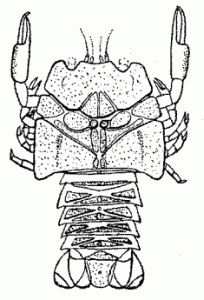
Phylogeny: Eryonoidea : (Eryonidae + (Palaeopentacheles + (Coleiidae + Polychelidae))) + *
Comments: Tetrachela raiblana is the most basal Eryonoid and the only species in the monotypal family Tetrachelidae. It is distinguished from most other eryonoids by the retention of the diaeresis of the uropodal exopods. (Wikipedia, Ahyong 2009). This flattened, wide-bodied type, like its successors, was a shallow water epifaunal form
Image credits Tetrachela raiblana (Bronn, 1858), from the Treatise (Glaessner 1969 fig 272) via Ahyong 2009 fig 1 A
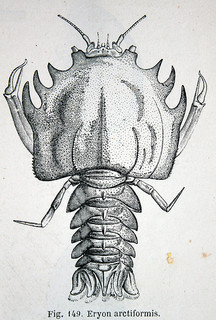
Eryonidae De Haan, 1841
Late Triassic to Early Cretaceous
Phylogeny: Eryonoidea : Tetrachela + ((Palaeopentacheles + (Coleiidae + Polychelidae)) + *)
Comments: - The "classic" eryonoids with the distinctive discoidal carapace. In the analysis of Ahyong 2009, Eryon Desmarest, 1822 and Cycleryon Glaessner, 1965 are closely related and form a crown group, Knebelia Van Straelen, 1922 is more basal MAK120531
Image credits Eryon arctiformis Image from Louis Figuier, La Terre avant le déluge Paris : Librairie de L. Hachette, 1863. - 2e éd., courtesy El Bibliomata, Creative Commons Attribution
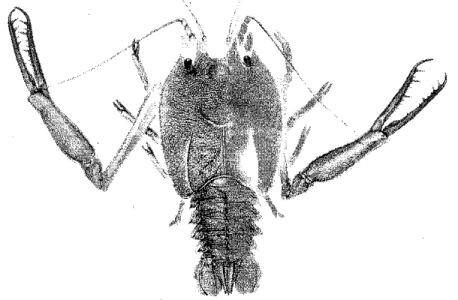
Phylogeny: Eryonoidea : Tetrachela + (Eryonidae + ((Coleiidae + Polychelidae) + *))
Comments: - Palaeopentacheles, formerly placed in Polychelidae, is demonstrated above to lie outside a Polychelidae + Coleiidae clade and has been placed in a monotypal family Palaeopentachelidae. Palaeopentacheles is presently known only from its type species, P. roettenbacheri from the Late Jurassic of Germany, illustrated here), and P. starri Schweitzer & Feldmann, 2001 from the Oligocene of North America. The holotype of the latter is in poor condition, and its assignment to Palaeopentacheles was tentative Ahyong 2009.
Image credits Palaeopentacheles roettenbacheri from Garassino & Schweigert 2006 via Ahyong 2009. Compare with photo of fossil in the Jura Museum Eichstaett and this reconstruction
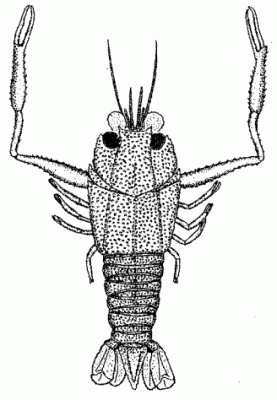
Coleiidae Van Straelen, 1924
Phylogeny: Eryonoidea : Tetrachela + (Eryonidae + (Palaeopentacheles + (Polychelidae + *)
Comments: Includes a number of genera. Intermediate between the flat-bodied Mesozoic types and the extant Polychelidae. The Late Triassic to the Late Jurassic Coleia Broderip, 1835 is the best known and includes a large number of species. Willemoesiocaris Van Straelen, 1925, from the mid-Jurassic of France, previously considered a polychelid (Glaessner 1969), is more likely a Coleiid (Ahyong 2009), although it is also possible that it could be a very primitive form transitional between the two groups MAK120531
Image credits Coleia longipes Fraas, 1855, from Schweigert & Died 1999 via Ahyong 2009 fig 1 E
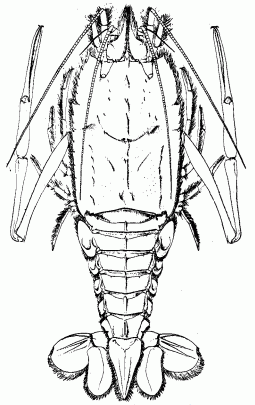
Polychelidae Wood-Mason, 1875
late Jurassic to Recent
Phylogeny: Eryonoidea : Tetrachela + (Eryonidae + (Palaeopentacheles + (Coleiidae + *)))
Comments: the only surviving Eryonoidae, represented by several genera and 38 extant species. All recent species are restricted to deep water. The eyes are vestigial, the body narrow in relation to earlier forms, the chelae have become less robust. Among extant taxa, the most primitive genus is Willemoesia, the most advanced Stereomastis and Polycheles Ahyong 2009, Wikipedia. The Jurassic Antarcticheles Aguirre-Urreta, et al. 1990, the only fossil genus included here, may be a Polychelidaen on features of the carapace, although the pereopods and tailfan are not known and carapace morphology may simply be convergent. Regardless, the close resemblanxce to contemporary taxa shows that the 'polychelid form' was already well established by the late Jurassic. Ahyong 2009.
Image credits The advanced Polychelid Stereomastis sculpta (from S.I. Smith, 1882) from Holthuis 1991, © FAO 1991, reproduced under permitted terms (noncommercial/educational)
Page MAK120531 Creative Commons Attribution